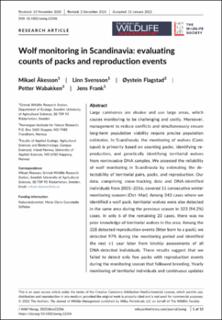| dc.contributor.author | Åkesson, Mikael | |
| dc.contributor.author | Svensson, Linn | |
| dc.contributor.author | Flagstad, Øystein | |
| dc.contributor.author | Wabakken, Petter | |
| dc.contributor.author | Frank, Jens | |
| dc.date.accessioned | 2022-08-03T09:02:36Z | |
| dc.date.available | 2022-08-03T09:02:36Z | |
| dc.date.created | 2022-04-01T10:13:39Z | |
| dc.date.issued | 2022 | |
| dc.identifier.citation | Journal of Wildlife Management. 2022, 86 . | en_US |
| dc.identifier.issn | 0022-541X | |
| dc.identifier.uri | https://hdl.handle.net/11250/3009908 | |
| dc.description.abstract | Large carnivores are elusive and use large areas, which causes monitoring to be challenging and costly. Moreover, management to reduce conflicts and simultaneously ensure long‐term population viability require precise population estimates. In Scandinavia, the monitoring of wolves (Canis lupus) is primarily based on counting packs, identifying reproduction, and genetically identifying territorial wolves from noninvasive DNA samples. We assessed the reliability of wolf monitoring in Scandinavia by estimating the detectability of territorial pairs, packs, and reproduction. Our data, comprising snow‐tracking data and DNA‐identified individuals from 2005–2016, covered 11 consecutive winter monitoring seasons (Oct–Mar). Among 343 cases where we identified a wolf pack, territorial wolves were also detected in the same area during the previous season in 323 (94.2%) cases. In only 6 of the remaining 20 cases, there was no prior knowledge of territorial wolves in the area. Among the 328 detected reproduction events (litter born to a pack), we detected 97% during the monitoring period and identified the rest ≥1 year later from kinship assessments of all DNA‐detected individuals. These results suggest that we failed to detect only few packs with reproduction events during the monitoring season that followed breeding. Yearly monitoring of territorial individuals and continuous updates of the pedigree allowed us to retrospectively identify reproduction events and packs that were not identified earlier. | en_US |
| dc.language.iso | eng | en_US |
| dc.relation.uri | https://wildlife.onlinelibrary.wiley.com/doi/epdf/10.1002/jwmg.22206 | |
| dc.rights | Navngivelse-Ikkekommersiell 4.0 Internasjonal | * |
| dc.rights.uri | http://creativecommons.org/licenses/by-nc/4.0/deed.no | * |
| dc.subject | Canis lupus | en_US |
| dc.subject | large carnivores | en_US |
| dc.subject | non‐invasive survey | en_US |
| dc.subject | pedigree | en_US |
| dc.subject | population monitoring | en_US |
| dc.subject | reproduction | en_US |
| dc.subject | Scandinavia | en_US |
| dc.subject | wolf | en_US |
| dc.title | Wolf monitoring in Scandinavia: evaluating counts of packs and reproduction events | en_US |
| dc.title.alternative | Wolf monitoring in Scandinavia: evaluating counts of packs and reproduction events | en_US |
| dc.type | Peer reviewed | en_US |
| dc.type | Journal article | en_US |
| dc.description.version | publishedVersion | en_US |
| dc.subject.nsi | VDP::Matematikk og Naturvitenskap: 400 | en_US |
| dc.source.pagenumber | 13 | en_US |
| dc.source.volume | 86 | en_US |
| dc.source.journal | Journal of Wildlife Management | en_US |
| dc.identifier.doi | 10.1002/jwmg.22206 | |
| dc.identifier.cristin | 2014457 | |
| cristin.ispublished | true | |
| cristin.fulltext | original | |
| cristin.qualitycode | 1 | |

